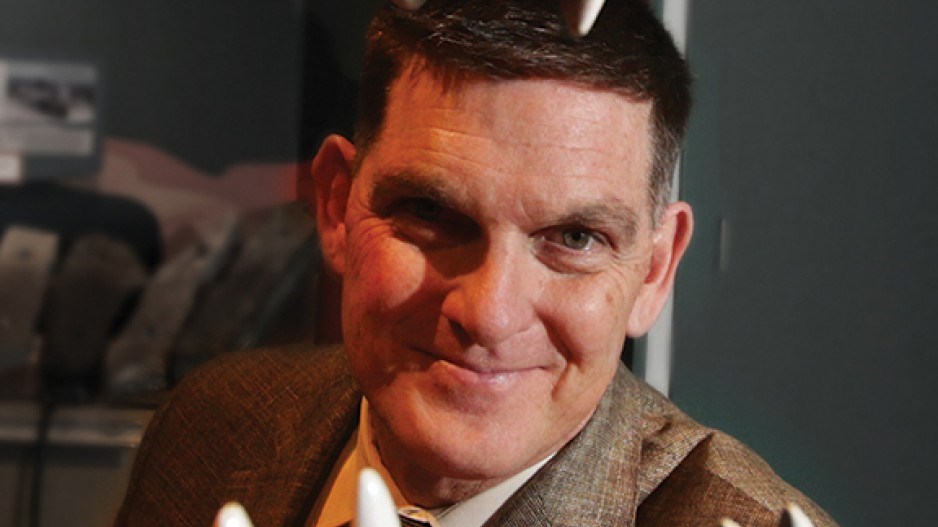By the age of four, Scott Sampson was in love with dinosaurs. By five he knew all their names, multiple syllables and all. The years passed, but somewhere along the line, the man who is now Science World’s president and CEO forgot to leave behind his capacity for Tyrannosaurus-sized enthusiasm.
“Like many kids, I was really passionate about dinosaurs,” he said. “And unlike most kids, I just never grew up.”
Sampson turned his childhood love into a full-blown career as a paleontologist. However, his journey from a childhood playing outdoors to his current role has been anything but predestined.
Born in 1961, Sampson grew up in Vancouver’s Dunbar neighbourhood and would often spend hours kicking around in the woods and dirt of the University of British Columbia’s (UBC) Endowment Lands.
Encouraged by his mother, Sampson got his hands dirty and found a deep love for the natural world. But once he got into high school, he found studying that world through the lens of formal science was much less fun.
“For me in high school, science was the experimental method,” said Sampson. “It was writing up an introduction and methods and a discussion and a conclusion about stuff that I didn’t care about.”
Science had lost its allure, and Sampson had soured on the whole process, as the classroom was a far cry from the forest close to his house. He stayed on the path of learning, graduating from high school in 1979 and headed to UBC, where he obtained his bachelor’s degree in anthropology. In his third year he rediscovered fossils, and found his way back to dinosaurs by completing his PhD in zoology at the University of Toronto in 2003.
His love was rekindled, but reflecting on his own experience in secondary school, he felt the public school system was still failing to inspire kids about science.
“We teach science like it’s all there in the textbook and we have all the answers,” he said. “And the reality is we don’t have all the answers, and we’re just beginning to unravel the universe and the natural world. Too often kids get the impression that it’s all figured out and there’s nothing left to do when in fact the opposite is true.”
By 2005 he had found success as an academic. He was a tenured professor at the University of Utah in Salt Lake City. Just a few hours from an important dinosaur fossil bed, Sampson was also the chief curator at a natural history museum on campus.
Yet before long he reached what he calls an “inflection point” in his life.
“I just decided for me, in all good conscience I couldn’t keep studying things that have been dead for millions of years – and getting graduate students to study these things when there are all these pressing things going on today that have to be changed in the next generation if we’re going to avoid a pretty dire course [for] humanity.”
Sampson upended his life and moved to California, where his wife had been offered a position at a university. He admits he had no plan – and that was the beauty of it.
“I threw a bomb in my life, and I said, ‘Nope I’m not going to do this.’”
Since then Sampson has taken a different approach to science. He hosted the Emmy-nominated PBS KIDS series Dinosaur Train, produced by the Jim Henson Co., and has been featured in more than a dozen documentaries, while also touring internationally as a public speaker. Sampson has also written two books, Dinosaur Odyssey: Fossil Threads in the Web of Life, which came out in 2009, and How to Raise a Wild Child: The Art and Science of Falling in Love with Nature, which came out in 2015. The latter book draws from his childhood digging around in the dirt in the forest, he said.
“I see humanity right now as disconnected from the natural world and the sustainability crisis as the result of that disconnect. And the only way for us to move towards a sustainable, thrivable world is we’re able to see ourselves as not above nature and outside of it, but within it.”
Kirk Johnson, director of the Smithsonian Institution’s National Museum of Natural History in Washington, D.C., praised Sampson, with whom he has worked on multiple occasions for various projects.
“First and foremost, Scott is a paleontologist,” Johnson said. “I’ve always been impressed by Scott’s ability to articulate an aspirational and optimistic future for people and planet Earth.”
Now as the head of Vancouver’s scientific mecca, Sampson said he is seeking a collaborative vision for the future of Science World, with input from the community about the direction of the non-profit organization.
He noted one thing Science World won’t be doing is lowering ticket prices to boost attendance – noting various studies across North America and Europe have shown such measures result in no sustained increase in turnout.
“It turns out for the most part it doesn’t work,” he said. “If you lower your ticket price by four or five bucks, or even 10 bucks, you don’t get that diversity of audience you were hoping for. And the reason is that you have to lower it to the point where you can’t function and meet your bottom line.”




